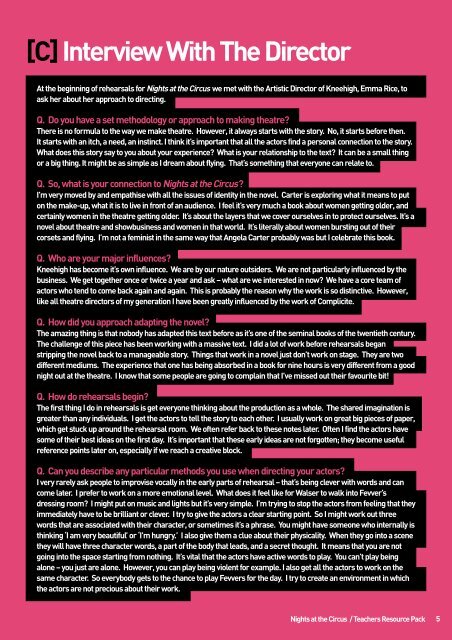Nights at the Circus - Kneehigh Theatre
Nights at the Circus - Kneehigh Theatre
Nights at the Circus - Kneehigh Theatre
You also want an ePaper? Increase the reach of your titles
YUMPU automatically turns print PDFs into web optimized ePapers that Google loves.
[C] Interview With The Director<br />
At <strong>the</strong> beginning of rehearsals for <strong>Nights</strong> <strong>at</strong> <strong>the</strong> <strong>Circus</strong> we met with <strong>the</strong> Artistic Director of <strong>Kneehigh</strong>, Emma Rice, to<br />
ask her about her approach to directing.<br />
Q. Do you have a set methodology or approach to making <strong>the</strong><strong>at</strong>re?<br />
There is no formula to <strong>the</strong> way we make <strong>the</strong><strong>at</strong>re. However, it always starts with <strong>the</strong> story. No, it starts before <strong>the</strong>n.<br />
It starts with an itch, a need, an instinct. I think it’s important th<strong>at</strong> all <strong>the</strong> actors find a personal connection to <strong>the</strong> story.<br />
Wh<strong>at</strong> does this story say to you about your experience? Wh<strong>at</strong> is your rel<strong>at</strong>ionship to <strong>the</strong> text? It can be a small thing<br />
or a big thing. It might be as simple as I dream about flying. Th<strong>at</strong>’s something th<strong>at</strong> everyone can rel<strong>at</strong>e to.<br />
Q. So, wh<strong>at</strong> is your connection to <strong>Nights</strong> <strong>at</strong> <strong>the</strong> <strong>Circus</strong>?<br />
I’m very moved by and emp<strong>at</strong>hise with all <strong>the</strong> issues of identity in <strong>the</strong> novel. Carter is exploring wh<strong>at</strong> it means to put<br />
on <strong>the</strong> make-up, wh<strong>at</strong> it is to live in front of an audience. I feel it’s very much a book about women getting older, and<br />
certainly women in <strong>the</strong> <strong>the</strong><strong>at</strong>re getting older. It’s about <strong>the</strong> layers th<strong>at</strong> we cover ourselves in to protect ourselves. It’s a<br />
novel about <strong>the</strong><strong>at</strong>re and showbusiness and women in th<strong>at</strong> world. It’s literally about women bursting out of <strong>the</strong>ir<br />
corsets and flying. I’m not a feminist in <strong>the</strong> same way th<strong>at</strong> Angela Carter probably was but I celebr<strong>at</strong>e this book.<br />
Q. Who are your major influences?<br />
<strong>Kneehigh</strong> has become it’s own influence. We are by our n<strong>at</strong>ure outsiders. We are not particularly influenced by <strong>the</strong><br />
business. We get toge<strong>the</strong>r once or twice a year and ask – wh<strong>at</strong> are we interested in now? We have a core team of<br />
actors who tend to come back again and again. This is probably <strong>the</strong> reason why <strong>the</strong> work is so distinctive. However,<br />
like all <strong>the</strong><strong>at</strong>re directors of my gener<strong>at</strong>ion I have been gre<strong>at</strong>ly influenced by <strong>the</strong> work of Complicite.<br />
Q. How did you approach adapting <strong>the</strong> novel?<br />
The amazing thing is th<strong>at</strong> nobody has adapted this text before as it’s one of <strong>the</strong> seminal books of <strong>the</strong> twentieth century.<br />
The challenge of this piece has been working with a massive text. I did a lot of work before rehearsals began<br />
stripping <strong>the</strong> novel back to a manageable story. Things th<strong>at</strong> work in a novel just don’t work on stage. They are two<br />
different mediums. The experience th<strong>at</strong> one has being absorbed in a book for nine hours is very different from a good<br />
night out <strong>at</strong> <strong>the</strong> <strong>the</strong><strong>at</strong>re. I know th<strong>at</strong> some people are going to complain th<strong>at</strong> I’ve missed out <strong>the</strong>ir favourite bit!<br />
Q. How do rehearsals begin?<br />
The first thing I do in rehearsals is get everyone thinking about <strong>the</strong> production as a whole. The shared imagin<strong>at</strong>ion is<br />
gre<strong>at</strong>er than any individuals. I get <strong>the</strong> actors to tell <strong>the</strong> story to each o<strong>the</strong>r. I usually work on gre<strong>at</strong> big pieces of paper,<br />
which get stuck up around <strong>the</strong> rehearsal room. We often refer back to <strong>the</strong>se notes l<strong>at</strong>er. Often I find <strong>the</strong> actors have<br />
some of <strong>the</strong>ir best ideas on <strong>the</strong> first day. It’s important th<strong>at</strong> <strong>the</strong>se early ideas are not forgotten; <strong>the</strong>y become useful<br />
reference points l<strong>at</strong>er on, especially if we reach a cre<strong>at</strong>ive block.<br />
Q. Can you describe any particular methods you use when directing your actors?<br />
I very rarely ask people to improvise vocally in <strong>the</strong> early parts of rehearsal – th<strong>at</strong>’s being clever with words and can<br />
come l<strong>at</strong>er. I prefer to work on a more emotional level. Wh<strong>at</strong> does it feel like for Walser to walk into Fevver’s<br />
dressing room? I might put on music and lights but it’s very simple. I’m trying to stop <strong>the</strong> actors from feeling th<strong>at</strong> <strong>the</strong>y<br />
immedi<strong>at</strong>ely have to be brilliant or clever. I try to give <strong>the</strong> actors a clear starting point. So I might work out three<br />
words th<strong>at</strong> are associ<strong>at</strong>ed with <strong>the</strong>ir character, or sometimes it’s a phrase. You might have someone who internally is<br />
thinking ‘I am very beautiful’ or ‘I’m hungry.’ I also give <strong>the</strong>m a clue about <strong>the</strong>ir physicality. When <strong>the</strong>y go into a scene<br />
<strong>the</strong>y will have three character words, a part of <strong>the</strong> body th<strong>at</strong> leads, and a secret thought. It means th<strong>at</strong> you are not<br />
going into <strong>the</strong> space starting from nothing. It’s vital th<strong>at</strong> <strong>the</strong> actors have active words to play. You can’t play being<br />
alone – you just are alone. However, you can play being violent for example. I also get all <strong>the</strong> actors to work on <strong>the</strong><br />
same character. So everybody gets to <strong>the</strong> chance to play Fevvers for <strong>the</strong> day. I try to cre<strong>at</strong>e an environment in which<br />
<strong>the</strong> actors are not precious about <strong>the</strong>ir work.<br />
<strong>Nights</strong> <strong>at</strong> <strong>the</strong> <strong>Circus</strong> / Teachers Resource Pack<br />
5


